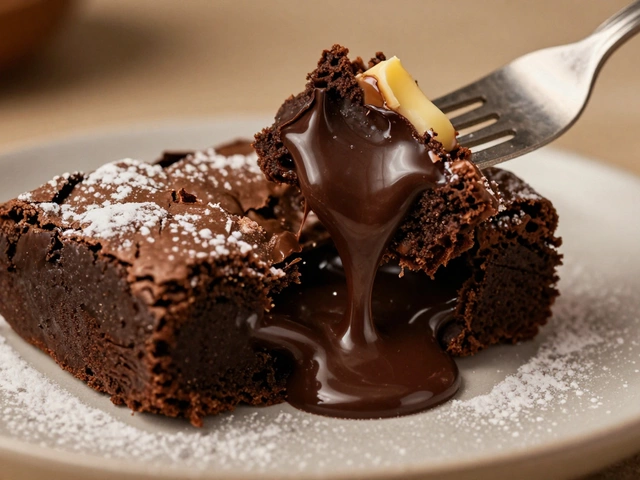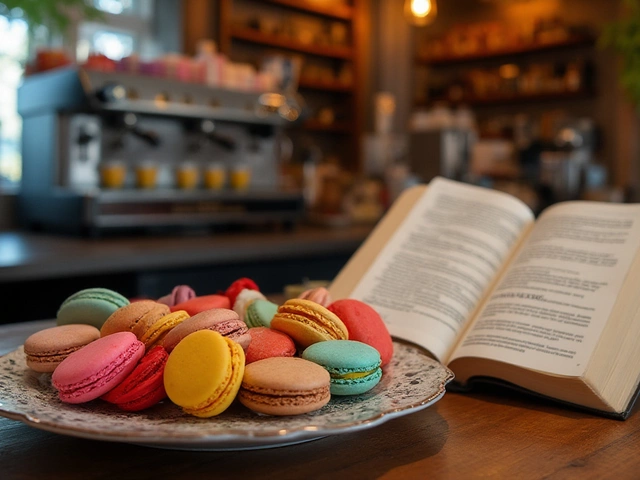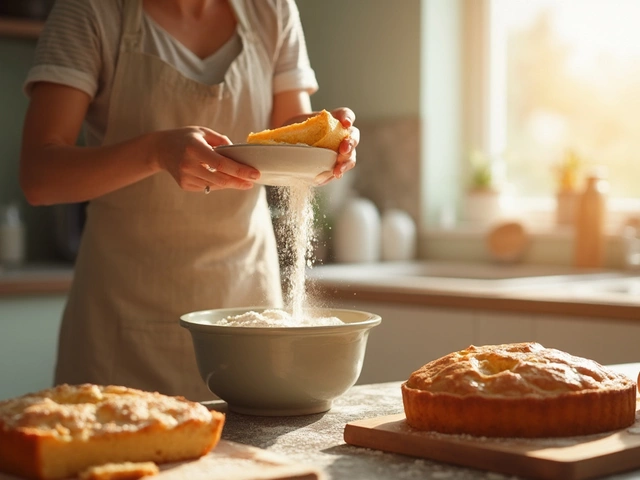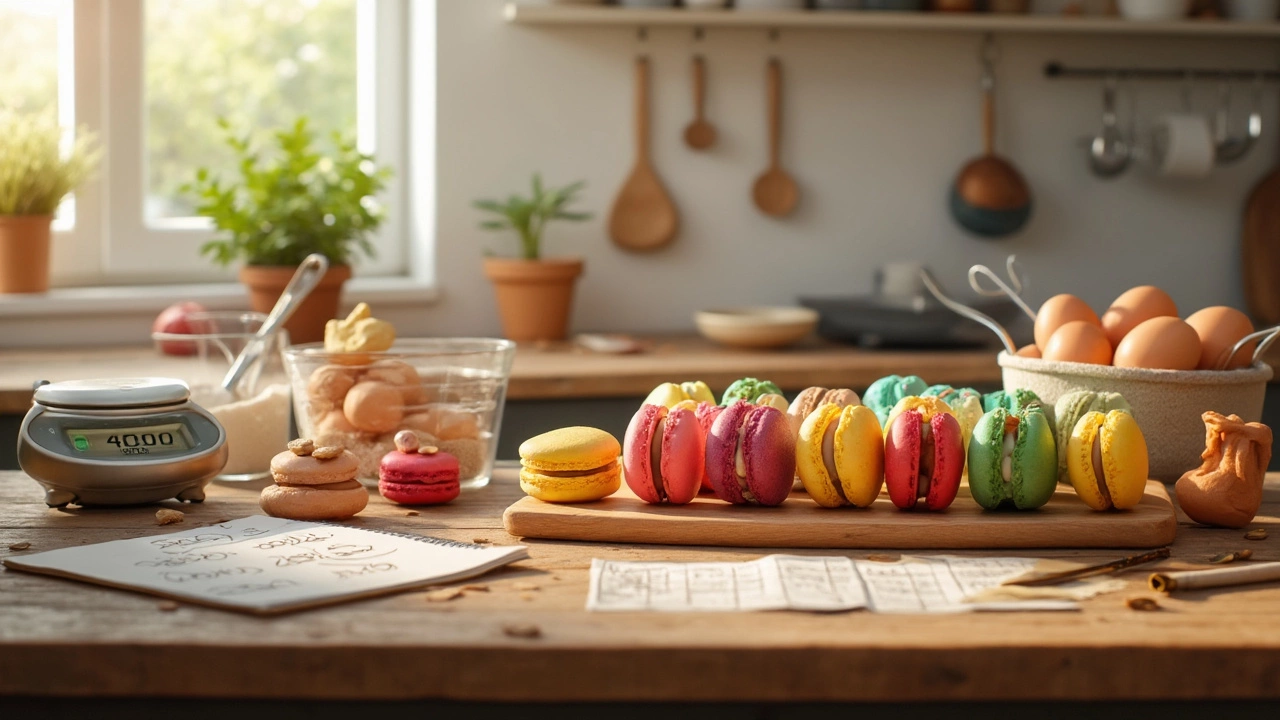
Macarons look adorable and taste amazing, but have you ever wondered how much it actually costs to make a batch at home? Spoiler alert: it’s not just about a few basic ingredients. If you’ve seen the price tags in bakery windows, you’re probably hoping DIY is the cheaper path. But is it really?
The truth is, getting those perfectly smooth shells and creamy filling involves some special (and sometimes expensive) ingredients. Almond flour, for example, isn’t cheap. Add in egg whites, powdered sugar, and a bit of food coloring, and your shopping cart fills up fast. And don’t forget—the right tools, like a kitchen scale and a decent mixer, can make or break your results.
Before you grab your wallet or run to the baking aisle, let’s break down the real numbers. From the grocery list to those hidden costs nobody talks about (hello, cracked shells!), knowing what you’re in for means fewer surprises in the kitchen.
- Macaron Ingredients: What's Essential and Pricey
- Equipment: One-Time Vs. Everyday Costs
- Hidden Expenses: Electricity, Time, and Mishaps
- Homemade Vs. Store-Bought: Which is Cheaper?
- Money-Saving Hacks for Macaron Lovers
- Extra Tips and Fun Macaron Facts
Macaron Ingredients: What's Essential and Pricey
Let’s get real—the main reason macarons are so pricey (in bakeries and at home) is the ingredients. No, you can’t swap almond flour for regular flour and expect the classic macaron lift or chew. The star here is almond flour, and that’s where most of your money goes. In the U.S., you’ll easily pay $8–$12 for a one-pound bag of good-quality almond flour. A standard macaron recipe uses about 125 grams (roughly 1 1/4 cups) for just 12–15 shells. See how quickly the cost adds up?
Next, there are egg whites. You’ll need them fresh, at room temperature—no shortcuts. One batch usually takes 2–3 egg whites. Not too pricey in themselves, but waste can happen fast if your first try flops.
Powdered sugar and granulated sugar round out the base recipe. You’ll use more of the powdered stuff than you think (around 200 grams or 2 cups per batch). Luckily, these sugars are cheap. Vanilla, cocoa powder, or food gel colors might seem like small details, but specialty extracts and quality colors can drive up the bill if you want those bakery-bright hues.
- Almond flour – Expect to spend most here
- Egg whites – Make sure they’re fresh
- Powdered sugar – Buy a bigger bag, you’ll use lots
- Granulated sugar
- Optional: food coloring, real vanilla, cocoa powder
For those who like numbers (or want to double-check if homemade beats the store), here’s what a basic macaron ingredient list might cost per batch:
| Ingredient | Average Cost Per Batch (USD) |
|---|---|
| Almond flour (125g) | $2.50 |
| Egg whites (3) | $0.75 |
| Powdered sugar (200g) | $0.50 |
| Granulated sugar (100g) | $0.30 |
| Food coloring/Vanilla | $0.40 |
| Total | $4.45 |
If you want fillings like buttercream or ganache, that’s extra. Butter, chocolate, and cream quickly make the per-macaron price creep up. So while the ingredient list fits on a post-it, the price—especially for almond flour—doesn’t lie. For true macaron cost comparison, remember this: one failed batch and you might end up spending double.
Equipment: One-Time Vs. Everyday Costs
Making macarons isn’t like whipping up regular cookies—you need the right gear, and some of it you buy once, while other stuff keeps costing you every time you bake.
Let’s talk about the must-have equipment. First up: a digital kitchen scale. For macarons, exact amounts really matter. A decent scale will set you back around $15 to $30, but it’ll last you ages and helps cut down on recipe flops. Next, you’ll want a stand mixer or a hand mixer to whip up those egg whites. A simple hand mixer can cost about $25, but if you’re baking a lot (or get seriously into macarons), a stand mixer runs $200 or more. Honestly, a hand mixer works just fine when starting out.
You’ll also need some reusable tools:
- Baking sheets: Most home bakers already have these, but quality trays can cost $10–$20 each.
- Silicone baking mats or parchment paper: Reusable mats cost $10–$15, while parchment needs replacing every bake. If you bake regularly, mats save money.
- Piping bags and tips: Disposable bags cost less at first, but if you’re serious, invest $10–$20 in reusable bags and a basic piping tip (round #12 works great).
Everyday costs come from supplies you need to replace all the time. Parchment paper, cleaning materials, and disposable bags add up, especially if you bake often. If you ditch the paper and disposables for silicone mats and reusable bags, your ongoing costs drop fast.
A lot of these are up-front costs, so your first batch (or two) feels pricey. But gear like mats, trays, and scales will last for years. If you plan to make macarons more than once, these one-time buys start to pay off fast compared to always buying macarons in the store. If you want to keep your macaron cost low, invest in reusable gear and avoid splurging on fancy gadgets.
Hidden Expenses: Electricity, Time, and Mishaps
When you’re thinking about the macaron cost, it’s easy to only count the price of flour and sugar, but there’s a lot more going on. First, don’t forget that electric mixer running for 10-15 minutes or your oven preheating for almost an hour eats up a bunch of energy. Some home bakers say each batch of macarons adds about 1-2 kWh to their bills, which for most folks in the US is roughly 20-30 cents per batch, but that can add up if you’re baking often.
Your time is another sneaky expense. Macarons aren’t a quick project. You’ll spend at least an hour separating eggs, sifting almond flour, folding batter, piping, resting, and baking—even when things go smoothly. Mess up the batter once and you’re repeating the whole process. If you run a quick check, a standard batch (about 25-30 macarons) easily eats up two hours, more if you’re new or running into problems.
Mistakes can get expensive, too. Any home baker who’s tried macarons knows that shells crack, feet fail, or whole trays come out sticky. Some research shows about one out of every three bakers ends up tossing their first batch. That’s wasted ingredients and time. Almond flour alone can cost close to $6 per pound, and those first ruined batches can hit your wallet hard.
| Hidden Expense | Average Cost per Batch |
|---|---|
| Electricity (mixer + oven) | $0.20–$0.30 |
| Time (per 2 hours, if valued at $15/hour) | $30.00 |
| Lost Ingredients (mistakes, per failed batch) | $3.00–$5.00 |
If you’re counting every penny, keep these extras in your budget. The first few attempts might cost a bit more while you learn. Just know, even pro bakers sometimes have to pitch a tray or two before getting those perfect, smooth shells.
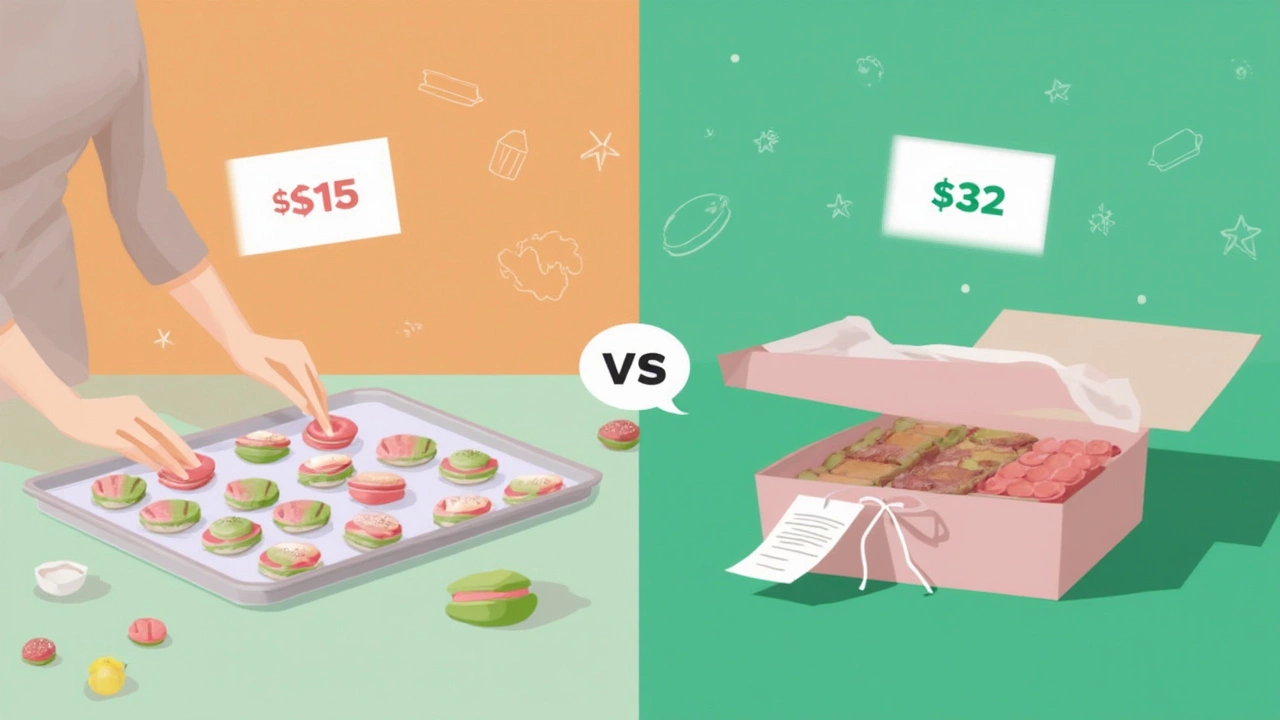
Homemade Vs. Store-Bought: Which is Cheaper?
So, what's actually cheaper: whipping up macarons in your kitchen or grabbing a box from your favorite bakery? Let’s do some math that makes sense in real life.
If you go to a decent bakery, you’ll pay between $2 and $3 for one macaron—sometimes even more if it’s a fancy flavor or from a premium brand. A box of six can easily hit $15 or more, especially in big cities or upscale groceries. It adds up crazy fast for a few bites of airy sweetness.
Now, let’s talk about making them at home. To bake about 20-24 standard macarons, here’s roughly what you’ll spend (based on average prices in 2025):
- Almond flour (150g): about $3
- Powdered sugar (150g): about $0.50
- Egg whites (from 3 large eggs): around $1
- Granulated sugar (100g): about $0.25
- Gel food coloring and flavoring: about $1 for the batch
So for the basic macaron cost on ingredients alone, you’re looking at $5-$6 per batch. That’s about $0.25 per cookie if you don’t count kitchen equipment or electricity. If you’re just making a one-off batch and need to buy a silicone mat or a scale, add another $15-$40 to your first run, but these pay off over time.
The catch? Homemade macarons come with some "oops" moments, especially if you’re new to the process. Recipes flop, shells crack, and sometimes you lose a batch to humidity or unstable meringue. So if half your first tray flops, your cost per perfect cookie goes up.
But if you nail the method and bake regularly, homemade macarons definitely beat the store price by a mile. Plus, you control the flavors and the sugar level and skip weird preservatives. For the casual baker, it’s a fun project that usually saves money in the long run, even when you factor in some failed tries or splurging on a new mixer.
Bottom line: for day-to-day munching or big parties, making macarons at home is the way to stretch your budget—after the learning curve. If you’re buying just a couple or want zero hassle, bakery treats are quick but way pricier.
Money-Saving Hacks for Macaron Lovers
The truth: making macarons can eat up your wallet fast, but there are smart ways to keep costs down without sacrificing that famous chewy bite. Here’s how you can cut corners, but not quality.
- Buy almond flour in bulk. Seriously, this is where most of your money goes. Purchasing a big bag online or at a warehouse store often drops the price per kilo by up to 40%. Store it in an airtight container so it stays fresh.
- Swap out pricey ingredients when you can. If you aren’t in a competition, try mixing almond flour with a little bit of ground blanched sunflower seeds. It won’t taste exactly the same, but it’s way cheaper and still works for that smooth batter.
- Use powdered food colors instead of liquid. You’ll use way less, and powders usually last longer in your pantry.
- Go for a basic ganache or buttercream filling instead of fancier (and pricier) options that need extra ingredients and flavorings.
- Share ingredients with friends if you’re all baking. Splitting up a giant bag of almond flour or sugar saves everyone money and cuts down on waste.
- Reuse baking paper or invest in a silicone mat — the upfront cost is higher for the mat, but you’ll save over time by ditching single-use parchment paper.
Mistakes happen even to pros, but you can avoid tossing out whole failed batches. Freeze shells that crack or don’t look perfect and crumble them on ice cream or in yogurt. You can also practice piping with plain egg whites and powdered sugar to get your hand steady before using the expensive stuff.
Take a look at the numbers. Here’s a quick rundown of the typical cost for a 24-macaron batch in the United States as of 2025:
| Ingredient/Item | Cost (approx.) |
|---|---|
| Almond flour (150g) | $3.50 |
| Powdered sugar (150g) | $0.45 |
| Egg whites (from 3 large eggs) | $0.60 |
| Granulated sugar (150g) | $0.30 |
| Food coloring (per batch) | $0.20 |
| Filling (butter, chocolate, etc.) | $1.50 |
| Electricity/gas (estimate) | $0.25 |
| Total | $6.80 |
If you keep these hacks in mind, you’ll actually get more macarons for your money than buying from most bakeries (where a single macaron can cost $2 to $4).
Extra Tips and Fun Macaron Facts
Let’s be real: baking macarons isn’t just about following a recipe. Sometimes it’s the “little things” that trip you up and make the difference between dropping $30 at the bakery or nailing a perfect batch at home.
- Macaron cost drops fast if you make big batches, since most ingredients (like almond flour and sugar) don’t spoil quickly. You can save a ton buying these in bulk, especially at wholesale stores or online.
- Your kitchen’s humidity can wreck a whole tray. Macarons need to rest before baking so their shells form a skin. But if your kitchen is humid, skip laundry day—extra moisture in the air can keep them from setting right.
- Parchment paper or silicone mats matter. Silicone baking mats sound like a splurge, but they help prevent sticking and let you use less parchment over time. For regular bakers, these pay for themselves after a couple batches.
- If you’re struggling with lumpy batter, sift your almond flour and powdered sugar before mixing—it stops blobs from ruining those smooth shells.
- Cracked shells? Not whipped enough egg whites or maybe you overmixed the batter. It’s a balancing act, but you’ll get the hang of it.
Now for some fun macaron trivia. Macarons and macaroons aren’t the same. French macarons are those colorful sandwich cookies we love, while macaroons are the coconut guys. Big difference! Also, the world's most expensive macarons once sold for over $7,000 a box in Switzerland—mostly because of rare ingredients and pure gold dust (not joking).
One last tip: let your macarons rest overnight in the fridge before eating. This extra time helps the flavors mingle and makes the centers even more delicious.

